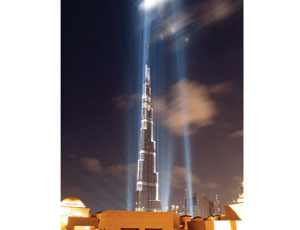Arthur Gensler, the architect of Shanghai Tower, on its way up to 632 meters, refers to the 5.5-million-sq-ft supertower as a vertical city. The tower is designed as a series of stacked, 14-story communities, separated by podiums, or town squares, filled with coffee shops and other amenities. Taken to a greater extreme, a vertical city’s hamlets could have doctors’ offices, schools, clothing shops, movie theaters, grocery stores, restaurants, cobblers, a post office, bookstores and more.

The idea is to mass each supertall building into discrete blocks of occupancies, whether office, hotel or housing, with each block virtually self-sufficient. The elevator becomes the subway. In combination with retail, services and recreational facilities at the podium levels, one might never have to leave the building. Life is lived in a bubble.
In a place like Dubai, where few people really want to go outdoors for much of the year because of desert dust, pollution and high temperatures, perhaps a sealed life is a good thing. The developer of the Burj Khalifa just “opened” its 828-m-tall skyscraper. And though it has a high-end hotel, condominium residences and some office space, Emaar is not touting the burj as a vertical city. The firm considers the burj the centerpiece of a $20-billion, mixed-use development including hotels, office buildings, an artificial lake and a 12-million-sq-ft mall with 4 million sq ft of stores. Burj occupants will have to exit the tower to go to the mall, but they won’t have to go outside—at least not outside the protected compound.
What’s wrong with a sealed vertical city or sealed compound? At first glance, the idea sounds almost utopian. But what are the long-term sociological and psychological implications? On closer scrutiny, the vertical city and the Dubai compound share something fundamentally disturbing: They are both for the super-rich. In a society where the rich are intentionally separated from the poor, the full impact may not be felt. But in a democratic society, isolating the “haves” from the “have nots” could create a powder keg.

Post a comment to this article
Report Abusive Comment